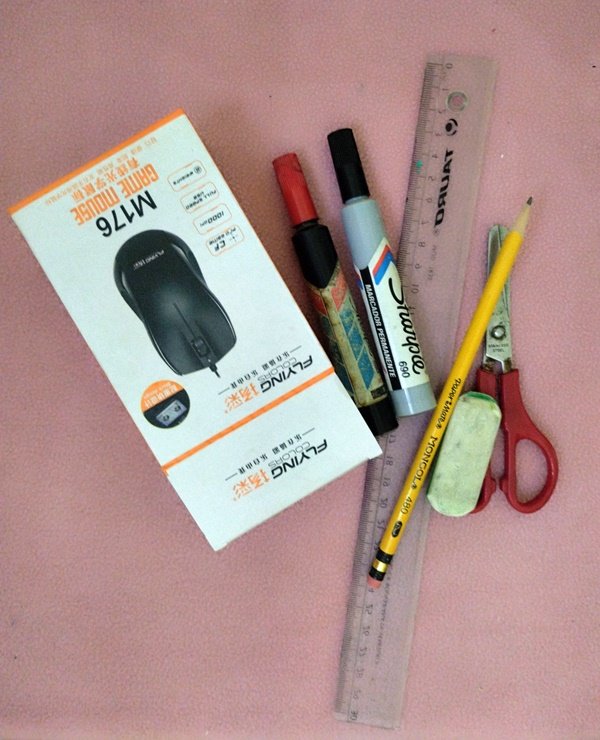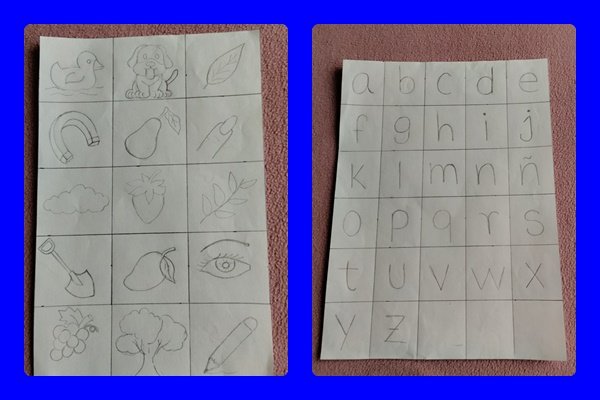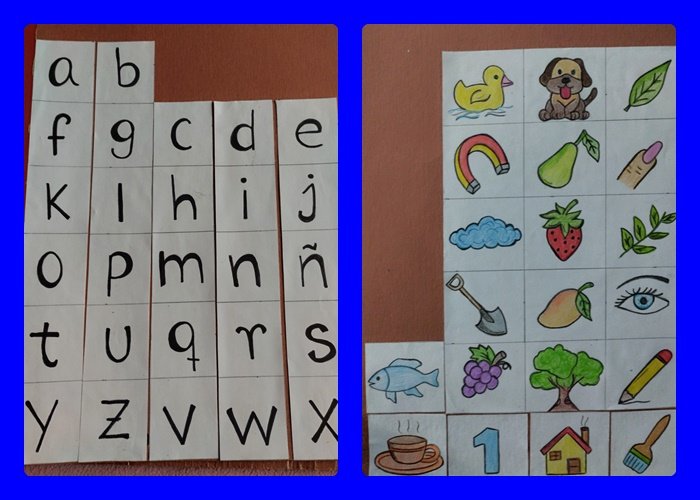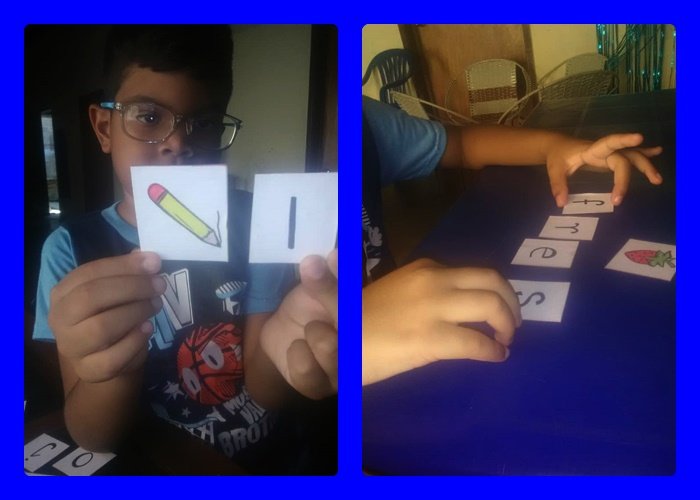Juego didáctico para formar palabras [Esp-Ing]

Hola hivers, educar es un proceso hermoso que implica esfuerzo, sacrificio y dedicación, pero el placer de enseñar es realmente gratificante. Me complace ayudar en la formación de otros, investigar y diseñar estrategias de aprendizaje que sean versátiles y prácticas. En esa oportunidad, me remonté a mi infancia cuando mi mamá me enseñaba a formar palabras en un cuaderno. Ella también posee cierta habilidad para dibujar, quizás de allí venga mi pasión por el arte, mi madre me hacía diferentes figuras para que yo las identificara. Quise convertir ese recuerdo en un juego didáctico para reforzar los conocimientos silábicos del pequeño César Mathías.
Entonces me dispuse a buscar algunos materiales para empezar con este proyecto:
- Carpetas
- Tijera
- Hojas recicladas
- Lápiz
- Pega blanca
- Colores
- Marcador
- Regla
Hi hivers, educating is a beautiful process that involves effort, sacrifice and dedication, but the pleasure of teaching is truly rewarding. I take pleasure in helping in the education of others, researching and designing learning strategies that are versatile and practical. In that opportunity, I went back to my childhood when my mom used to teach me how to form words in a notebook. She also has a certain ability to draw, maybe that's where my passion for art comes from, my mother used to make different figures for me to identify. I wanted to turn that memory into a didactic game to reinforce the syllabic knowledge of little César Mathías.
So I set out to find some materials to start with this project:
- Folders
- Scissors
- Recycled sheets
- Pencil
- White glue
- Colored pencils
- Marker
- Rule

Procedimiento:
Busqué algunas imágenes referenciales en internet, figuras relativamente fáciles adecuadas al desarrollo cognitivo del niño, por ejemplo: fresas, uvas, pala, mata, imán, pez, mango, ramo, uno, lápiz, hoja, casa, nube, brocha, pato, perro, entre otras. Realicé unos 20 dibujos.
Marqué los bocetos en papel, luego coloreé cada uno. Hice cuadros de 4,5 cm de largo por 4 cm de ancho. Con una tijera recorté las figuras y las pegué en las carpetas. Luego, las saqué de forma individual.
Procedure:
I looked for some reference images on the internet, relatively easy figures suitable for the child's cognitive development, for example: strawberries, grapes, shovel, bush, magnet, fish, mango, bouquet, one, pencil, leaf, house, cloud, paintbrush, duck, dog, among others. I made about 20 drawings.
I marked the sketches on paper, then colored each one. I made squares 4.5 cm long by 4 cm wide. With a scissors I cut out the figures and glued them into the folders. Then I took them out individually.

Posteriormente, realicé el abecedario, repetí el mismo procedimiento que utilicé para las imágenes y las repasé con el marcador. En caso de que una palabra tenga la misma vocal varias veces se tendrían que hacer algunas fichas adicionales, verbigracia: mata o pala.
Coloqué las figuras en la mesa y el abecedario arriba de las mismas. Los ojos del infante se mostraban curiosos, capturé su atención. Le di algunas instrucciones, entonces seleccionó imágenes al azar y empezó a colocar sus nombres. Estaba muy concentrado buscando, en ocasiones decía los sonidos en voz alta para hacer más fácil la identificación. Cuando necesitaba un poco de ayuda lo orientaba, ya que se confundía con la "b" y la "d" o con algunos sonidos complejos, a pesar de su conocimiento previo.
Afterwards, I made the alphabet, repeated the same procedure I used for the images and went over them with the marker. In case a word has the same vowel several times, some additional cards would have to be made, for example: tree or shovel in spanish.
I placed the figures on the table and the alphabet on top of them. The infant's eyes were curious, I captured his attention. I gave him some instructions, then he randomly selected pictures and began to place their names. He was very focused looking, sometimes saying the sounds out loud to make identification easier. When he needed a little help I guided him, as he got confused with the "b" and "d" or some complex sounds, despite his prior knowledge.


En cuanto a las imágenes, el niño pudo reconocerlas rápidamente. Le pedí que las ubicara en los objetos de la casa y lo hizo de forma eficiente, siempre debemos relacionar el aprendizaje con la cotidianidad, así será más sencillo internalizarlo y comprenderlo. Considero que esta actividad fue adecuada para continuar con el reforzamiento en casa. Espero que les haya sido de utilidad.
As for the images, the child was able to recognize them quickly. I asked him to place them in the objects of the house and he did it efficiently, we should always relate learning to everyday life, so it will be easier to internalize and understand it. I consider that this activity was adequate to continue with the reinforcement at home. I hope it has been useful.


#posh
https://twitter.com/miuriel2015/status/1630326629426769921
https://twitter.com/3152522968/status/1630326629426769921
https://twitter.com/45890363/status/1630360120990244866
The rewards earned on this comment will go directly to the people( @ramisey, @irvinc ) sharing the post on Twitter as long as they are registered with @poshtoken. Sign up at https://hiveposh.com.
Una forma creativa de ayudar con el proceso de lectura. Cuando mis hijos estaban en edad escolar les llenaba la casa con cartelitos con el nombre de los objetos. Gracias por compartir estimada @ramisey. Que estés bien. Un fuerte abrazo desde Maracay.
Esa también es una buena idea, querido amigo. Agradecida por tu comentario y visita, siempre bienvenido por aquí. Recibe otro fuerte abrazo de regreso. Saludos.
Feliz noche.
I should appreciate your drawing, they look nice. Your child is learning from a lot for sure. ☺️
I have always liked to draw, thanks for stopping by, we are still on the learning path. Greetings.
You're welcome. ☺️
Linda y colorida estratégia, llamativa para los pequeños.
Gracias por tus lindas palabras, seguimos buscando las mejores estrategias para enseñar. Saludos.
Su post ha sido valorado por @ramonycajal
Muy buena idea, para aprender a formar palabras. Saludos